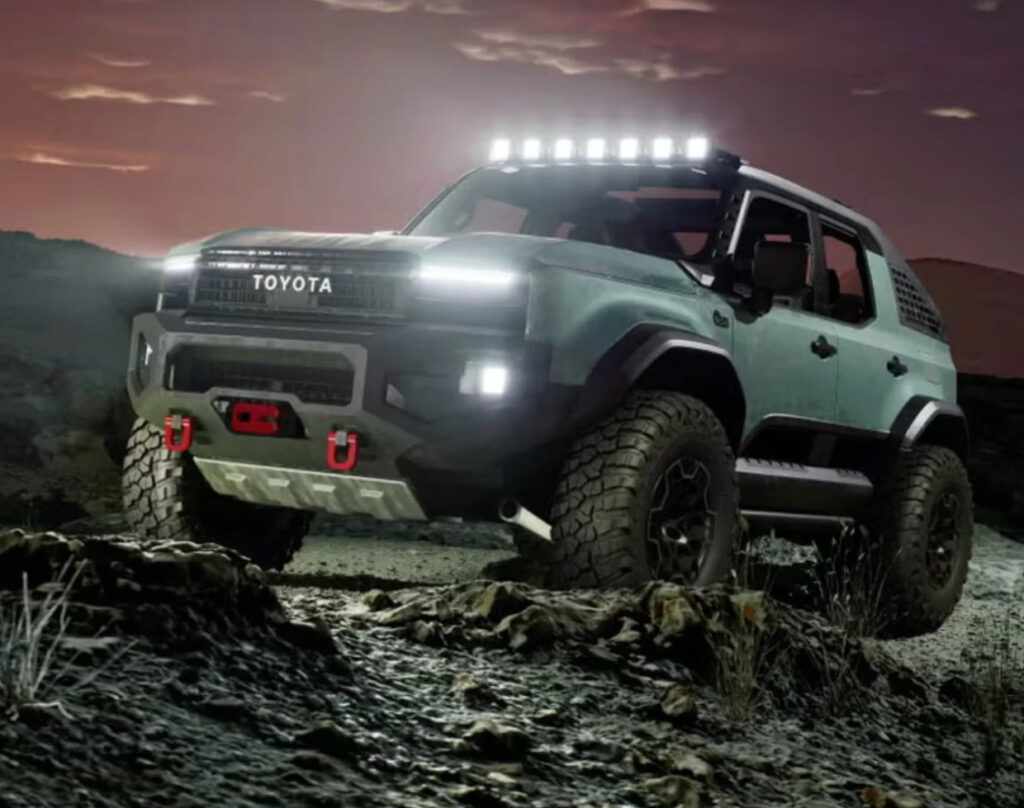A Radical Reimagining of the Automotive-Terrain Relationship
In an era when SUVs are less about sport or utility and more about wireless charging ports and luxury cocooning, Toyota’s Calty Design Research Studio has detonated a conceptual depth charge. Revealed in April 2025, the Toyota Land Cruiser ROX isn’t a car in the conventional sense. It’s not even a “vehicle” by current standards. It’s a 1.8-ton architectural intervention, a moving exoskeleton for traversing untamed landscapes.
Gone are the doors. Gone are the windows. Gone is any attempt at insulation. In their place stands a steel latticework that wears terrain like a prosthesis wears flesh. The ROX does not shield you from the environment—it weds you to it.
A Vehicle Unmade: Deconstructing the ROX
The Frame as Interface
At first glance, the ROX seems like a half-built machine. But every exposed weld, every gap in its structure is by design. The 3D-printed steel skeleton serves simultaneously as a chassis, roll cage, and multi-axis gear interface. It does not just support movement—it choreographs interaction.
Over 47% of its body is composed of open air, a deliberate rejection of enclosed automotive design. This is “negative space engineering,” not for aesthetics but for sensory fidelity. You feel the trail in your chest, not just through tires.
What’s Missing Is What Matters Most
Where most automakers focus on what to add—more screens, more soundproofing—Toyota subtracts:
- Windshield? Replaced by HUD-equipped AR goggles.
- Doors? Reimagined as a single equestrian-style step-through.
- Climate control? Unnecessary—seats are made from electrostatic mesh that regulates temperature via the body’s own microcurrents.
Materials as Narrative
- Bare steel: Unpainted to flaunt welds and stress lines—what Calty calls “topographical tattoos.”
- Floorboards: Bio-composite panels made of hemp and aluminum, echoing both sustainability and resilience.
- Hubs: Fitted with ceramic bearings that self-lubricate under pressure, functioning more like human joints than machine parts.
This is brutalism on wheels—raw, exposed, and unashamed.
Brutalist Mobility: The ROX Manifesto
The ROX’s design DNA reads like a declaration of war against luxury’s sterility. At its core, it embodies three key heresies:
Sensory Overload Isn’t a Bug—It’s the Feature
Where traditional SUVs insulate, the ROX amplifies:
- Wind buffets your helmet as a tactile speedometer.
- Dust clings to your skin, reading the trail like braille.
- Scent—sage, salt, smoke—becomes a shifting olfactory atmosphere.
The ROX turns sensation into data.
The Death of the Automotive Cocoon
Calty openly derides the SUV-as-living-room model. The ROX is designed like a 19th-century safari vehicle with the function-first mindset of a NASA lunar rover, combined with the adaptive armor philosophy of the samurai. It doesn’t comfort. It conditions.
Designed to Patina
The ROX isn’t meant to stay pristine.
- Surfaces oxidize like corten steel, developing a durable skin of rust-resistance.
- Each dent is a memory. Each scrape, a map.
- UV exposure alters the texture, building a living, shifting livery.
In essence: the more you scar it, the better it looks.
Rewriting the Human-Machine Interface
A New Driving Position
Forget reclining captain’s chairs. The ROX places you in a saddle-style seat with a 35-degree pelvic tilt, activating your core like horseback riding.
- A bare magnesium wheel vibrates with every stone and divot.
- Foot chocks operate like motorcycle pegs—heel/toe pivots, no floor pedals.
This isn’t sitting. It’s riding.
The Equipment Ecosystem
Nothing is stowed. Everything is integrated.
- Magnetic tool rails act like a surgeon’s tray—tools visible, ready, worn.
- Hydration bladders slot into the seats, not cupholders.
- Rope guides traverse the frame like veins, suggesting this is less “vehicle” than exosuit.
Augmented Reality as Windshield
- Navigation is beamed directly into AR goggles, overlaying topography and GPS data in real-time.
- Haptic feedback suits vibrate to signal proximity to terrain hazards.
- The steering column analyzes grip strength and cortisol levels, offering a real-time stress readout.
The ROX doesn’t just react to the world. It feels with you.
Why It Matters: The ROX as Counterculture Catalyst
The SUV Authenticity Crisis
Let’s face it: Most so-called off-roaders never leave the Whole Foods parking lot. Toyota calls the bluff with a machine that asks:
“If you’re not willing to get dirty, what’s the point of pretending you’re rugged?”
The ROX exposes modern SUVs as empathy shields, not exploration tools.
Manufacturing Revolution
This isn’t just about looks. It’s about industrial efficiency:
- 60% fewer parts than a standard Land Cruiser.
- No paint shop required—saving 400kg CO₂ per unit.
- 3D-printed subframes reduce tooling and human labor by 75%.
Toyota’s research is compelling:
“Over-insulation from risk breeds anxiety.”
By removing the walls, the ROX doesn’t increase danger. It reintroduces trust in human instinct, skill, and decision-making. Risk becomes art. Control becomes connection.
Artifact or Omen?
The ROX won’t go on sale. Not this year. Probably not ever.
But its influence is already metastasizing:
- Tacoma 2027 will integrate ROX’s modular rail system.
- Lexus 2028 EVs will leverage its 3D-printing chassis tech.
- Toyota’s upcoming models will embrace visible “witness marks” as part of their design language.
What began as a concept now infects the real—transforming the mythos of mobility.
As Calty’s Chief Designer Hunter Palmer says:
“We didn’t build a vehicle. We built a permission slip.”
Technical Specifications
- Powertrain: Prototype hydrogen-combustion hybrid
- Chassis: 3D-printed steel exoskeleton
- Suspension: Solid axles with piezoelectric dampers
- Weight: 1,812 kg (3,995 lbs)
- Approach/Departure Angles: 47° / 52°
- Doors, Roof, Glass: None
- Production Forecast: Zero units. Intentional.
The Toyota ROX isn’t a prototype—it’s a provocation. It dares to ask:
When did we decide that adventure should happen behind glass?
In the raw steel curves of its chassis, in the absence of every comfort we’ve grown to expect, the ROX presents a radical invitation: to feel again, to risk again, to roam again.
And that, more than any horsepower figure or infotainment spec, is what makes it a truly revolutionary machine.
No comments yet.









